“Woh! I’m dipping my hair in this blue dye…“
High Heeled Giants, “Blue Dye” (2019)
Introduction
Each group consisted of three members. Each group was reshuffled from their membership as they had in the weeks prior. I, coincidentally, was in the group of the same name as those weeks prior – Group F – this time consisting of Gisele Nelson ’25, Elek Thomas-Toth ’25, and myself, Ashton Macklin ’27. As described in the respective Lab Journal, this week’s lab was a continuation of the focus of the prior week’s lab on wool and woolworking. This week’s focus was on dyeing, and as last week, was facilitated by Alejandra Sanchez, a guest woolworker, shepherdess, and textile artist based out of Wisconsin, recently relocated from Minnesota.
Setup and chaîne opératoire
This lab saw us create four hues with three dyes. To produce these dyes, there were three cast iron pots and tripod sets. To accommodate the fewer amount of pots that groups, the six groups were divided by three, assigning two groups to each pot. Our group was paired with Group E in producing a dye from Marigolds.

Because our group’s end goal was a green color, this involved the blending and coordination of two respective dyes: that made of the marigold “tea” and the indigo tincture. The importance of occounting for the weight of the respective fiber being dyed (in this case ‘weight’ is indirectly referring to density), does not translate to indigo or mordanting dyes, as indigo instills a surface bond rather than a chemical bond. ‘Surface’ here refers to the fact that indigo as a substance becomes embedded into the material, rather than fundamentally changing the chemical composition of the material to a resulting blue. For further reference, a mordanting dye is a dye that uses a mordant alongside the pigment, or a dye that itself acts as a mordant, which is a substance that chemically binds the pigment to what is being dyed, increasing colourfastness.
The efficacy of the indigo dye was also partially dependent on maintaining a slightly alkaline pH. This was maintained through the addition of soda ash to the tincture prior to the insertion of the to-be-dyed material. Prior to inserting any material into the indigo, it must have been made wet, then wrung out. This was to allow the dye to seep into the material efficiently and evenly through the capillary effect. Doing so also neutralizes the pH of the material ever-so-slightly prior to its insertion into the indigo. It also prevented the sticking of particulate indigo, or globules/chunks of indigo to get stuck in the material. This applied to yarn as much as it did to people’s hair at the conclusion of the lab.

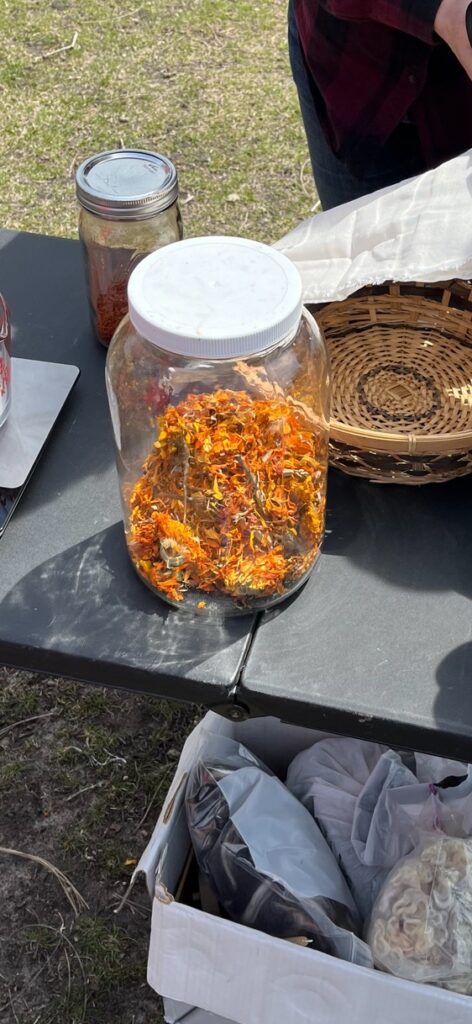
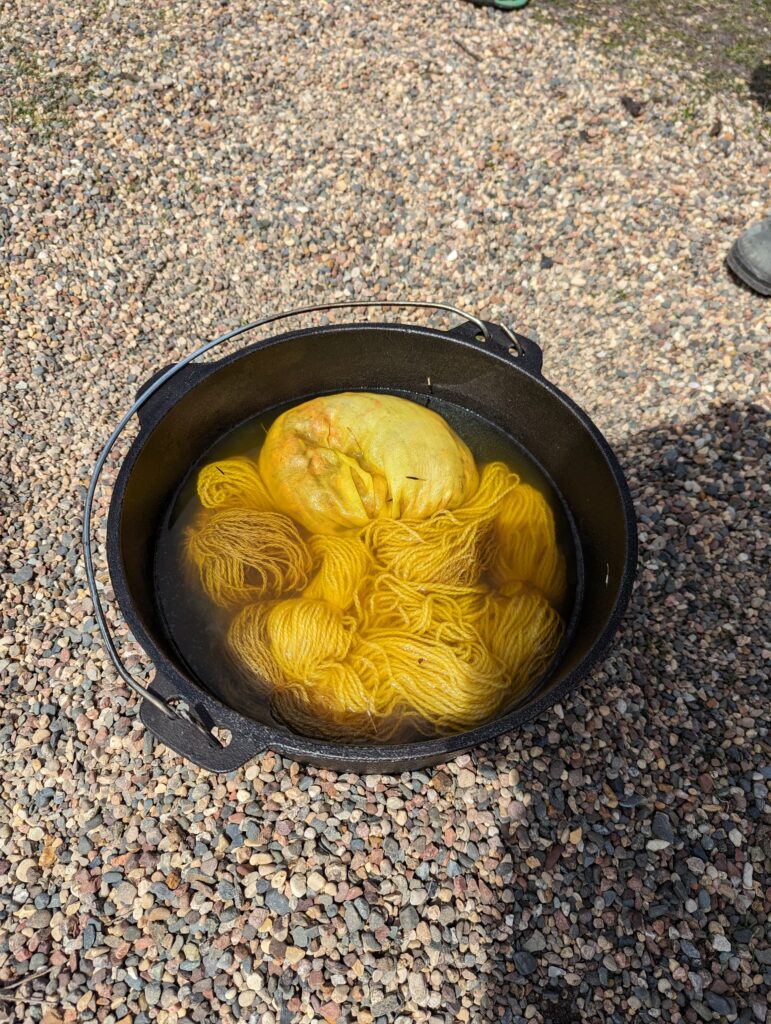

Hypothetical situational variables
In the execution of the experiment, there were some situational variables that may have affected the quality, or the replicability of various aspects of the lab.
Experimental
Indiscriminate variables:
Our group, was tasked with making a green dye — a process which required making a marigold “tea”, which functioned as a yellow dye, then dying the then-made-yellow yarn with a tincture of blue, indigo dye, prepared by Alejandra. Prior to dying, the natural sheep’s wool yarn our group was assigned, was of a natural brown colouration. If the experimental process were standardized, and variables were reduced, there exists a possible variable in:
- How different in colour would the resulting shade of yarn appear if we utilized a different base natural shade of yarn?
- Would a “bleached”, but originally naturally darker/brown shade of yarn be more receptive to dye? i.e., would the yarn take upon a darker colour? (This is not considering the chemical effects of whatever method of bleaching) is utilized.
As affecting the process of dying with marigolds:
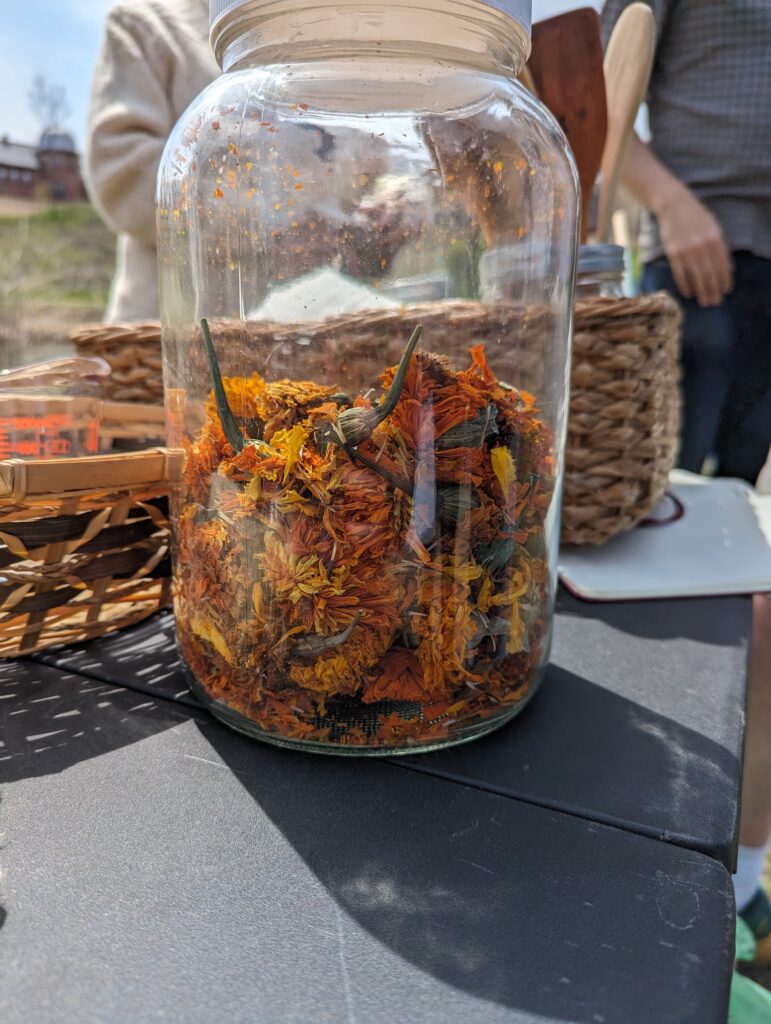
Yellow pigment (within which yarn would be dipped, let to slightly air dry for a short period of time, and then inserted into the indigo tincture, producing a resulting green coloration), was extracted from the marigolds by preparing a “tea” of all components of the full, crude plant. This “tea” was made by placement of the crude marigold plant clippings into a cheesecloth, and then boiled in water in a cast iron cauldron over wood fire.
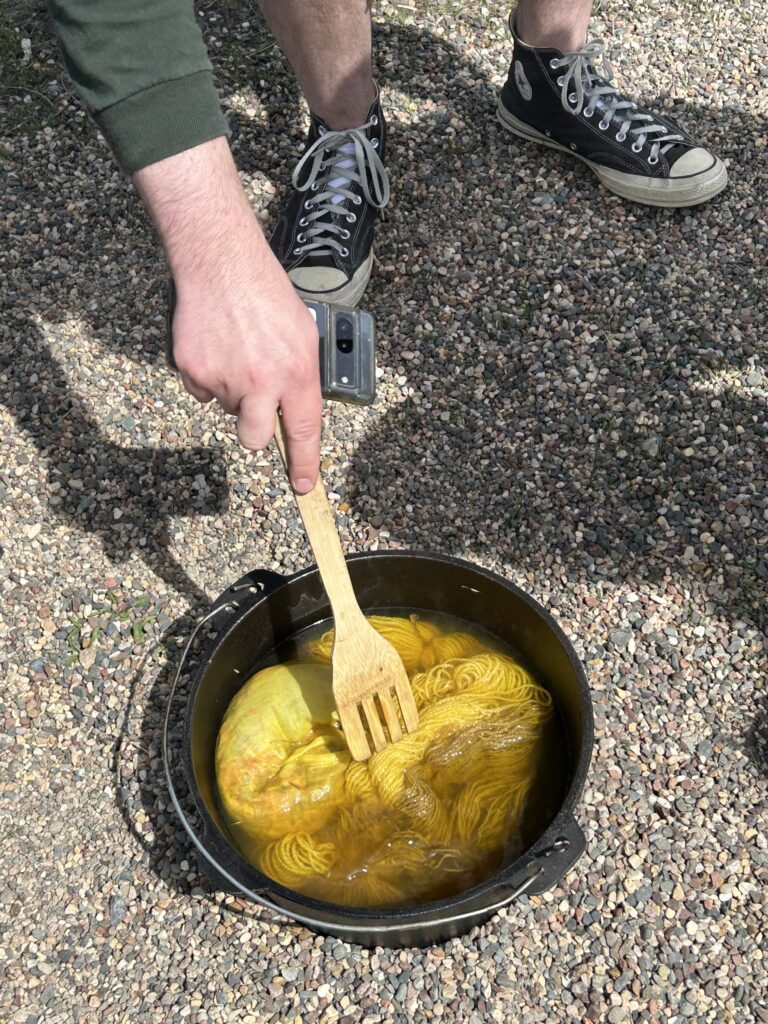
A wooden spatula is being used to push down a spool of brown yarn and the marigold “teabag”.
Prior to “steeping”, the marigolds had been dried thoroughly, but not ground or crushed — only snipped a few inches below the head to allow the plants to fit properly into the jar used for its storage. From my knowledge, I believe we were told that maintaining the full plant as the crude source of the “tea” was purposefuI, due to the fact that either: A) the production of a yellow dye is not dependent on, or sourced from, only the flower itself, but also the leaves — or B) the chemicals contained in the parts of the plant excluding the flower itself, contributed to other compounds in the tincture (“tea”) that allowed it to function as a true dye. For instance, perhaps the leaves or stem contain tannins — a chemical which can act as a darkening agent — or other compounds which contribute to the colourfastness or efficacy of the dye as being more than just a stain.
Because of these possibilities, I believe that there exists a few variables, whose manifest could maybe alter some factors surrounding our experiment:
- Would the time needed for “steeping” to a particular shade be reduced if the plant were ground or crushed?
- Would including only the flower, or only the stems and leaves of the marigold plant change the intensity of colour, transferability, or fastness of the dye? Any other factors?
- Would using butter muslin, silk, or a steel strainer to diffuse the marigolds result in a different diffusion rate, or a different amount of particulate matter left within the “tea”? Would a different amount of remnant particulate matter in the “tea” change the efficacy of the dye in any way?
- Would a longer boil time change the intensity of the dye, and if so how much? Is there a cap on colour intensity, and is it more so determined by the amount of water left remaining in the “tea” after boiling?
- Instead of inserting it into the “tea” after removing the cauldron from the fire, would boiling the yarn in the “tea” result in a stronger dye? An ineffective one?
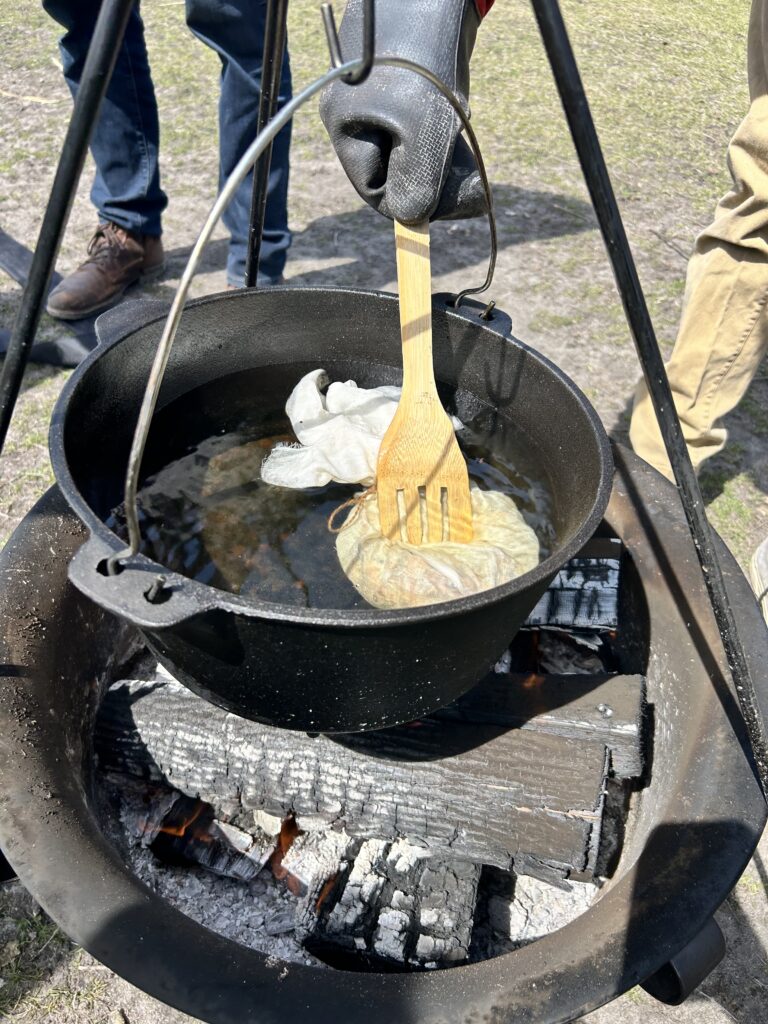
As affecting the process of dying with indigo:
As mentioned earlier, any material that was to be inserted into the indigo must have been made wet, then wrung out. This is for multiple reasons:
- To make the best usage of capillary action to evenly allow for even absorption of material into the fabric.
- To slightly neutralize the pH of the to-be-dyed material.
- (Post-inundation wringing is done) to prevent the dilution of the tincture of indigo, which is chemically reactive, and thus not only sensitive to losing potency through dilution, but also can oxidate or become altered chemically as a result of contact with water.
- To prevent the impregnation of the material with particulate indigo.
Considering these variables, improper wetting and wringing of the to-be-dyed material prior to insertion into the tincture of indigo could result in a comparatively ineffective or problematic dying process.
Environmental
Indiscriminate variables:
The day was particularly windy, manifesting as two variables that I could see as effecting the efficacy of various aspects of the lab. Other than the immediate consideration of being an open-field lab, the day itself was particularly windy, resulting in not only small particulate, such as sand, dust, seeds, dirt, or grass, to enter the cauldrons at various points when either boiling or still. While I have no way to confirm whether or not these manifested as a particularly significant effect upon the chemistry of our materials.
As affecting the process of dying with marigolds:
There seems (to me) to be fewer environmental variables that had specifically affected the efficacy or process of dying with the marigolds. Of those at hand, I do wonder if the cool humidity may have affected the originally-dry, crude plant, prior to inserting as a “tea”, in such a way that the dye may have diffused at a different rate depending thereupon.
As affecting the process of dying with indigo:
There also was the possibly more-significant variable, where, considering the efficacy of the indigo as a dye was dependent on the presence of oxygen in the environment, the wind, and the amount of time for which the dye was left exposed to air for the sake of slowly explaining different things about the chemistry of the indigo. This was noted by Alejandra, who stated that, due to the oxidizing-prone nature of the indigo, she had to periodically inundate the tincture with sodium hydrosulfite, also known as sodium dithionite, which functioned to deoxidize, or rather substitute elemental oxygen in the indigo, thereby slowing down the stabilization, and thus prolong the usefulness of the indigo as a dye.
Throughout the lab, Alejandra attempted to keep the tincture covered, but there were some periods of time wherein the indigo did remain uncovered for a significant period of time. The effect was noticeable, as the dye became progressively ineffective, but only at a noticeable degree after we concluded dying the bundles of yarn intended for the lab. At this point, some class members made use of the remaining indigo to dye their hair, clothing, or other natural fibres on hand. I had dyed a cotton polo with this “post-need” indigo, which required two dips to evenly distribute the same vivid colour as expressed on other dyed materials.
Additionally, the “lifespan” of the tincture depended on how well-disturbed the liquid is, as due to not being a true solution, the contents of the tincture were not fully dissolved nor evenly distributed therewithin. Therefore, depending on the length of the material being dyed, different depths to which the material is being inserted could determine the efficacy to which the dye could have properly inundated a particular section thereof. This was observed when I had dyed a cotton polo after the class had finished dying its yarn. It had required two dippings, despite being left in for slightly longer than was normally traditionally necessary to sustain an even coloration. This was also possibly influenced by the indigo tincture’s length of exposure to air by the time the class had begun dipping materials other than the yarn provided by Alejandra.
Method
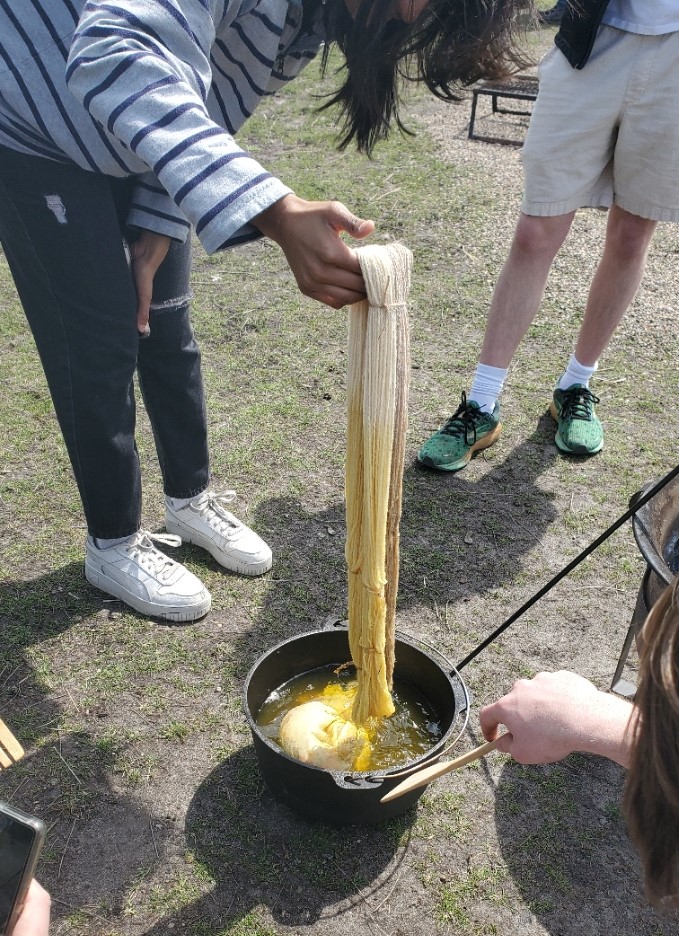
Marigold dying
50 grams worth of crude marigolds were placed into a cheesecloth “teabag” and then boiled in about a half-gallon of water in a cast iron cauldron. After the conclusion of the boil, the pot would be removed, then the yarn inserted, and all materials pushed down with a spatila to dye for about a minute. This “teabag” was 348 grams post-boil and post-inundation. Chamomile was measured in ratio of equivalence to 50% weight recorded from 100 grams of wool. (Weight being different than mass here)

Indigo dying
Brown wool was put in slowly, held under the suface for about seven second, then slowly pulled back out. Brown wool oxidized from greenish-yellow to blue.
The data
| Initial qualities | 13:46 | 13:52 | 14:10 | 14:18 | 14:23 | 15:06 | |
|---|---|---|---|---|---|---|---|
| Differentiating developments: | Indigo tincure was prepared first due to comparatively longer time needed for dye-readiness. Tincure was mixed then allowed to settle. | Water for “tea” put onto fire. Marigolds placed into “teabag” | Water for “tea” taken off of fire | “Teabag” inserted into tea | Wool inserted into “tea” at 14:19 | Cauldron removed from fire Siddharth accidentally spills some tea into fire | Wool removed from “tea”, left to dry |
| Quantitative obervations: | Temperature of indigo: 28.5 C / 82.7 F | Temp of water for “tea” 19 C / 66.2 F | Temp. of water for “tea” 32.22 C / 90 F | Temp. of water for “tea” 34.44 C / 94 F | Temp. of water for “tea” 37.78 C / 100 F | Temp. of water for “tea” 60 C / 140 F | Temp. of water for “tea” 82 C / 27.78 F “Teabag” was 358 grams after removal from tincture |
| Qualitative observations: | Indigo described as smelling slightly sulfurous | Marigolds described as smelling sweet — like chamomile. | pH was listed as being very alkaline; around 8.4 | Some particulate did escape cheesecloth “teabag”, settled to the bottom of cauldron after a few minutes. | Marigold “teabag” did not diffuse into water like true tea. | pH was noted as becoming very acidic; around 6.2 | Wool was a mulled yellow-brown; progressively became more yellow with drying |
Conclusion
The dying process was effective in producing, interestingly, a similar tone of considerably vibrant colouration across each of the four dyes — purple, yellow, blue, and in our group’s case, green. The method executed under the direction of Alejandra was therefore likely constructed to purposefully result in such. Notable was that, as each of the dyes dried over time, the intensity of colour within each one grew, demosntrating that a notable factor in vibrancy was not only the content of the dye, but how moisture tend to mull the interpreted result.
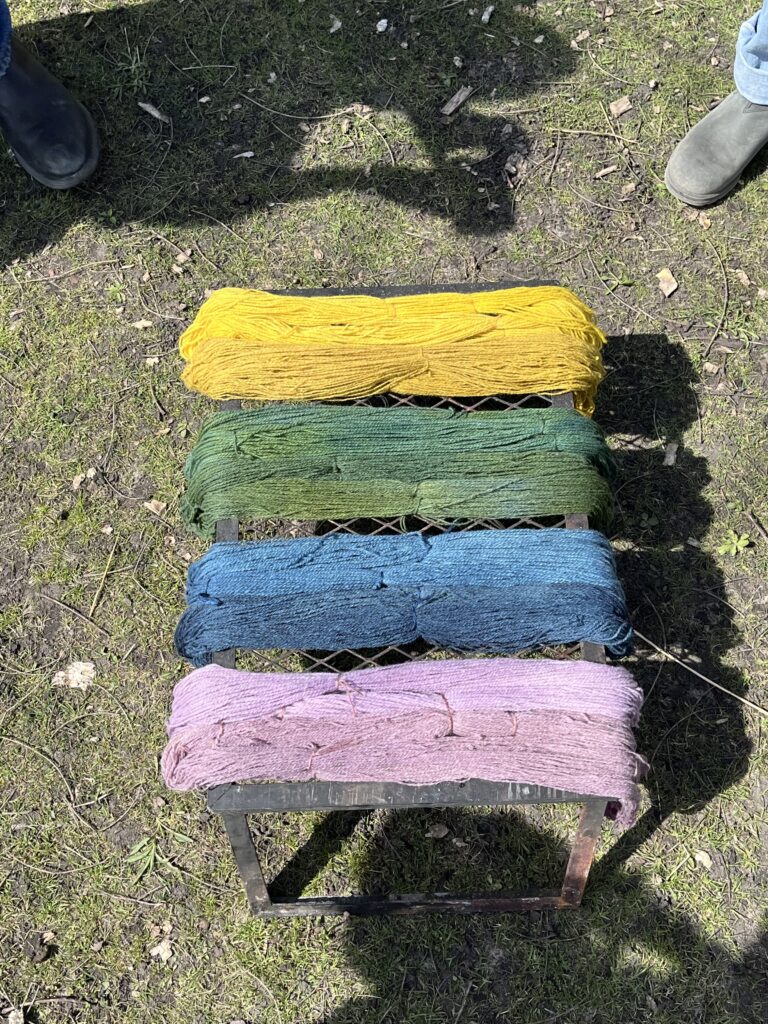


0 thoughts on “Lab Group Data, Group F; Week 5, Spring 2024: Dyeing”